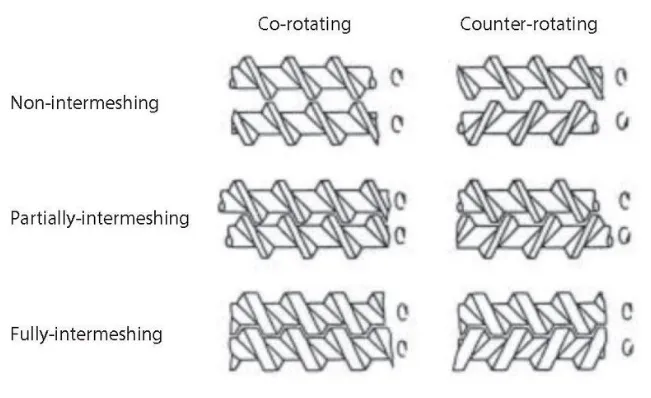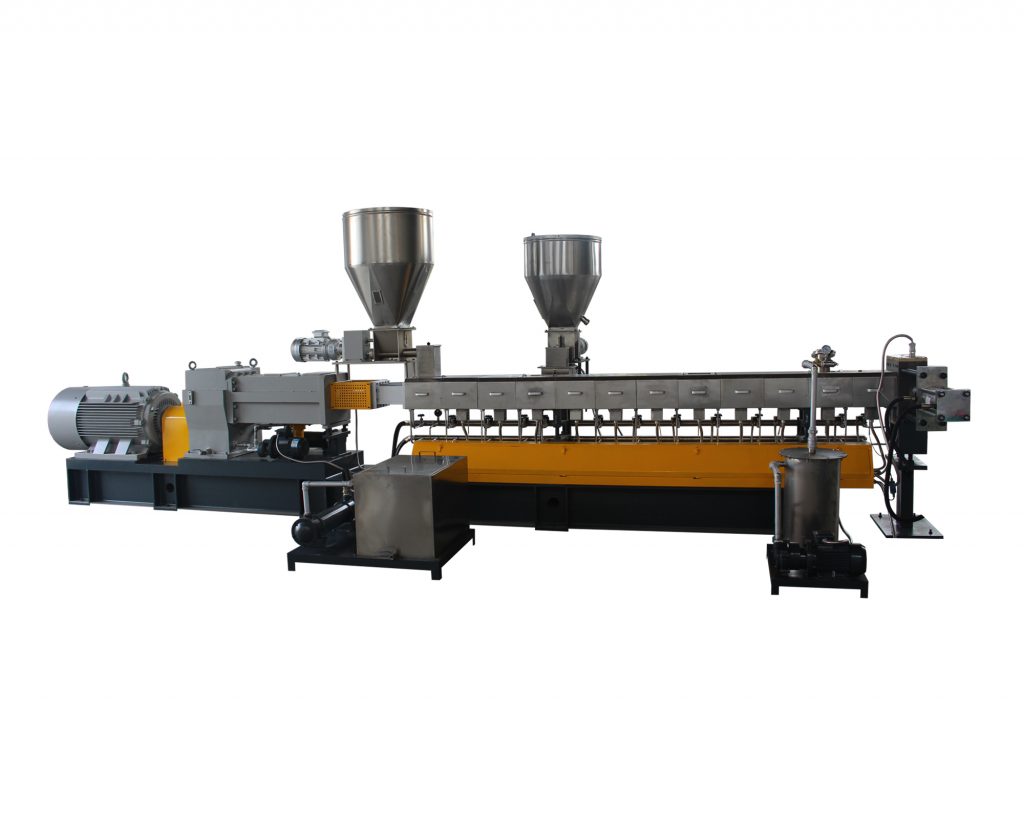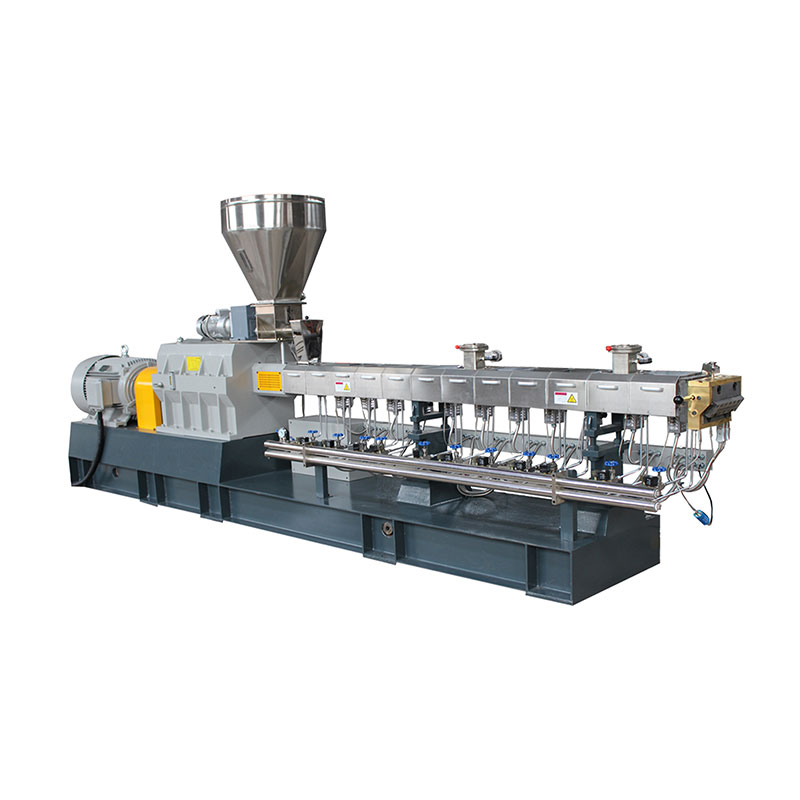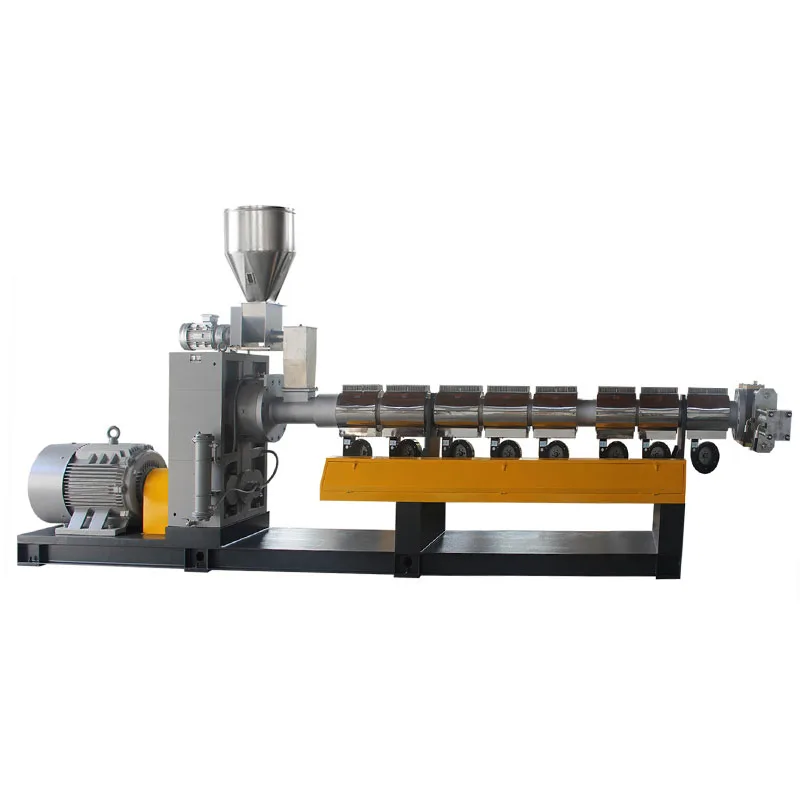What’s the difference between Twin Screw Extruder and Single Screw Extruder? What are the advantages and disadvantages of each? In this article, Granuwel will walk you through a detailed understanding of twin screw extruders and single screw extruders.
Innehållsförteckning
VäxlaTwin Screw Extruder VS. Enkelskruvextruder
Briefly, the main difference between a twin screw extruder and a single screw extruder lies in their structure. processing capabilities. and application.
A single screw extruder, equipped with one screw, is primarily designed for basic extrusion tasks such as material melting extrusion and forming.
In contrast, a twin screw extruder has two intermeshing screws that offer better mixing, compounding, and control, making it suitable for processing multiple materials or complex formulations. Twin screw extruders offer enhanced throughput, consistent quality, and superior mixing capabilities, whereas single screw extruders present a more cost-effective solution for sheet, film extrusion and plastic recycling granulation, etc.
Chart: Twin Screw Extruder vs Single Screw Extruder
| Twin Screw Extruder | Enkelskruvsextruder |
| Higher shear rate Suitable for the production of complex raw materials Less heat generated by friction Longer service life Better material mixing Controllable temperature Vacuum exhaust device Wide adaptability | Suitable for extrusion of less complex components Suitable for small-scale production More heat generated by friction Shorter service life Low adaptability |
If you intend to purchase an extruder but have no ideas about how to make the right choice, you can contact us. Granuwel is always happy to help you find high quality extruders that best suit your production needs.
If you want to learn more about twin screw extruders and single screw extruders, just go ahead and keep reading.
What Is Twin Screw Extruder?
Twin screw extruders, as the name implies, typically, they have two screws inside the barrel. Basically, the twin screw, co-rotating or counter-rotating, intermeshing, or non-intermeshing, work together to process materials. There are different types of twin screw, which affects the operating efficiency and capacity of the extruder. Below are the pictures of different types of twin screws that are widely used in polymer extrusion.

Image Source: ResearchGate
If you don’t know how to choose twin screw types, feel free to contact us! Granuwel is professional in the polymer extruding field, we’ll help you choose a twin screw extruder that best suits your production needs.
What Is Single Screw Extruder?
The single screw extruder has a single screw that rotates inside its barrel. As the material is fed into the hopper, it’s forced forward by the rotating screw, which melts and mixes the material before it’s extruded through a die.
Basic Structure of Twin Screw Extruders & Single Screw Extruders
| Twin Screw Extruders | Single Screw Extruders |
| Hopper & metric feeder DriveGearbox or reducer Barrel (With two screws inside) Multiple heating zones Barrel Cooling system (normally water cooling) Vacuum system Die for final pelletizing | Feed Hopper Drive Reducer Barrel (With one screw inside) Multiple heating zones Barrel cooling (normally air cooling) Die for final shaping |

Image Source: ScienceDirect
Key Differences Between Twin Screw & Single Screw Extruders
The number of screws is not the only difference between the two, and there are several other technical distinctions:
Operation:
Single screw extruders rely more on pressure build-up, while twin screw extruders focus on the shear force and dispersing ability for processing.
When the single screw rotates, it generates the pressure to push forward materials. The friction between the barrel, material and screw also contributes to some shear and the shear force is small. The volume of the screw groove is too large, which is not conducive to the generation of internal friction heat of the material, thus the energy consumption of heating is higher.but it is the pressure that mainly drives the extrusion process.
When two screws rotate in the barrel, the shear force is mainly generated between the two screws. As mentioned above – the two screw types affect the operating efficiency and capacity of the extruder, the reason is the generated shear force is different. It is the shear force that mainly mixes materials, the shear force can promote the generation of internal friction heat between materials, thus reducing the energy consumption of heating.
Mixing Capability:
Twin screw extruders offer better mixing capabilities than single screw extruders because of their unique dual-screw design. In twin screw extruders, the two screws either intermesh or work closely together, creating more intensive shear and better distribution of materials. This results in improved mixing and homogenization, especially when processing materials with additives, fillers, or multiple components.
Flexibility:
Single screw is only limited to the processing and application of one material, even if the processing of the same material, the screw for granulation and extrusion molding can not be universal.
Twin screw extruders are more versatile in processing a variety of materials than single screw extruders, because the shear force of twin screw extruders is more adjustable.
Applications of Twin Screw Extruders & Single Screw Extruders
Twin Screw Extruders Applications
PET extrusion:
· Filler masterbatches,
· Color masterbatches
· Additive masterbatches,
· Glass fiber reinforced, Flame retardant material pelletizing (such as: PA6, PA66, PET, PBT, PP. PC reinforced flame retardant, etc.)
· High filling material granulation (such as: PE, PP filled with 75% CaCO3.)
· HFFR/PVC/XLPE cable materials compounding
· High filling material granulation (such as: PE, PP filled with 75% CaCO3.)
· TPE/TPR/TPU/TPV compounding
· XLPE pipe material compounding
· HDPE pipe coating material compounding
· Hot melt adhesive, PU reactive extrusion granulation (such as: EVA hot melt adhesive, polyurethane)
· K resin and SBS devolatilization granulation
· Rubber devolatilization compounding
· etc.
Sheet direct extrusion
· PLA/PBAT + Corn Starch biodegradable material sheet Extrusion
PP Compounding with Wood Fiber and Sheet Extrusion
· PP Compounding with Talc and Sheet Extrusion
· BOPP Film Extrusion
· HDPE Waterproof Sheet
· BOPET Film Extrusion
· PVB/SGP Film for Laminated Glass
· EVA Film for Solar Cell Encapsulation
Aluminum-plastic composite & sheet extrusion
· etc.
PET extrusion:
·PET sheet
· PET film
· PET foam sheet/board
· PET recycling,
· etc.
Foam extrusion:
· XPS extruded board
· Graphite EPS beads
· PET foam
· XLPE foam sheet
· etc.
Single Screw Extruders Applications
Sheet extrusion:
· PVC sheets
· PET sheets
· PS sheets
· PP sheets
· PC sheets
· etc.
Pipe extrusion:
· PVC pipes
· PP-R pipes
· PE gas pipes
· ABS pipes
· PEX cross-linked pipes
· HDPE silicon core pipes
· Aluminum-plastic composite pipes
· HDPE silicon core pipes
· Various co-extruded composite pipes.
Plastic recycling pelletizing :
PP film chips
PE film chips
PET bottle
PA fishing fiber
etc
Advantages of Twin Screw Extruders & Single Screw Extruders
Twin Screw Extruders Advantages
Superior Mixing: They ensure thorough and uniform mixing of materials.
Flexibilitet: Capable of processing a wide range of materials, including high-viscosity ones.
Precise Control: Better control over extrusion parameters like temperature and pressure.
Efficiency: Faster processing times and increased productivity.
Mångsidighet: Configurable for different processing needs, such as venting. Side feeding .liquid injection etc
Improved Heat Transfer: Better handling of temperature-sensitive materials.
Self-Cleaning: Reduced downtime and maintenance between runs.

Explore Granuwel Twin Screw Extruder >>
Single Screw Extruders Advantages
Simplicity: They have a straightforward design, making them easier to operate and maintain.
Cost-Effective: Generally less expensive than twin screw extruders, both in terms of initial investment and maintenance.
Efficiency: Suitable for high-output production with good efficiency in processing certain materials.
Durability: Robust and reliable for continuous operation with minimal downtime.
How to Choose Between Twin Screw Extruders & Single Screw Extruders
Choosing between twin screw and single screw extruders depends on:
1.Processing Needs:
Twin Screw Extruders: Best for complex mixing and varied materials.
Single Screw Extruders: Suitable for simpler processes and high-output production.
2.Material Type:
Twin Screw Extruders: Handles high-viscosity and sensitive materials well.
Single Screw Extruders: Good for consistent, less complex materials.
3.Flexibility:
Twin Screw Extruders: More versatile and adaptable to different formulations.
Single Screw Extruders: Less flexible but effective for specific applications.
4.Cost:
Twin Screw Extruders: Higher initial and maintenance costs.
Single Screw Extruders: More cost-effective overall.
5.Energy Efficiency:
Twin Screw Extruders: Typically more energy-efficient.
Single Screw Extruders: May use more energy.
6.Maintenance:
Twin Screw Extruders: More complex and requires more maintenance.
Single Screw Extruders: Easier to clean and maintain.
Should you have any further queries regarding twin screw or single-screw extruders, do not hesitate to contact Granuwel for assistance.


